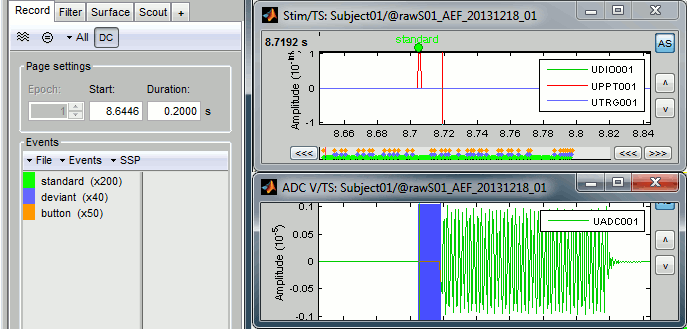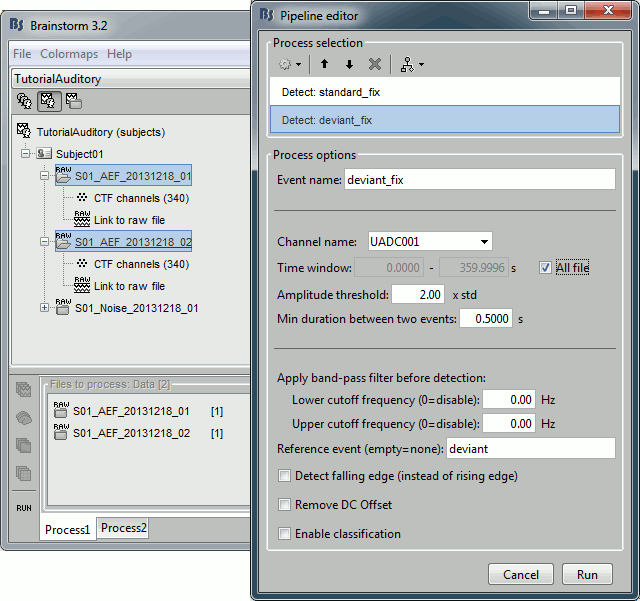|
⇤ ← Revision 1 as of 2015-02-03 23:15:42
Size: 5278
Comment:
|
Size: 5484
Comment:
|
| Deletions are marked like this. | Additions are marked like this. |
| Line 20: | Line 20: |
| === Evaluation === * Right-click on Run01/Link to raw file > '''Stim '''> Display time series (stimuls channel, UDIO001) Right-click on Run01/Link to raw file > '''ADC V''' > Display time series (audio signal generated, UADC001) |
|
| Line 21: | Line 23: |
| === Evaluation === * Right-click on Run01/Link to raw file > '''Stim '''> Display time series (stimuls channel, UDIO001) Right-click on Run01/Link to raw file > '''ADC V''' > Display time series (audio signal generated, UADC001) * In the Record tab, set the duration of display window to '''0.200s'''. Jump to the third event in the "standard" category. |
* In the Record tab, set the duration of display window to '''0.200s'''. Jump to the third event in the "standard" category. |
| Line 29: | Line 26: |
{{http://neuroimage.usc.edu/brainstorm/Tutorials/Auditory?action=AttachFile&do=get&target=stim1.gif|stim1.gif|height="282",width="590",class="attachment"}} |
. {{http://neuroimage.usc.edu/brainstorm/Tutorials/Auditory?action=AttachFile&do=get&target=stim1.gif|stim1.gif|height="282",width="590",class="attachment"}} |
| Line 35: | Line 31: |
| * Add '''twice''' the process "'''Events > Detect analog triggers'''". Once with event name="standard_fix" and reference event="standard". Once with event name="deviant_fix" and reference event="deviant". Set the other options as illustrated below: {{http://neuroimage.usc.edu/brainstorm/Tutorials/Auditory?action=AttachFile&do=get&target=stim2.gif|stim2.gif|class="attachment"}} |
* Add '''twice''' the process "'''Events > Detect analog triggers'''". Once with event name="standard_fix" and reference event="standard". Once with event name="deviant_fix" and reference event="deviant". Set the other options as illustrated below: . {{http://neuroimage.usc.edu/brainstorm/Tutorials/Auditory?action=AttachFile&do=get&target=stim2.gif|stim2.gif|class="attachment"}} |
| Line 42: | Line 34: |
{{http://neuroimage.usc.edu/brainstorm/Tutorials/Auditory?action=AttachFile&do=get&target=stim3.gif|stim3.gif|height="151",width="570",class="attachment"}} |
. {{http://neuroimage.usc.edu/brainstorm/Tutorials/Auditory?action=AttachFile&do=get&target=stim3.gif|stim3.gif|height="151",width="570",class="attachment"}} |
| Line 48: | Line 39: |
| . {{http://neuroimage.usc.edu/brainstorm/Tutorials/Auditory?action=AttachFile&do=get&target=stim5.gif|stim5.gif|height="149",width="502",class="attachment"}} * '''Important note''': We compensated for the jittered delays (delay #1), but not for the other ones (delays #2, #3 and #4). There is still a''' constant 5ms delay''' between the stimulus triggers ("standard" and "deviant") and the time where the sound actually reaches the subject's ears. |
|
| Line 49: | Line 42: |
| {{http://neuroimage.usc.edu/brainstorm/Tutorials/Auditory?action=AttachFile&do=get&target=stim5.gif|stim5.gif|height="149",width="502",class="attachment"}} * '''Important note''': We compensated for the jittered delays (delay #1), but not for the other ones (delays #2, #3 and #4). There is still a''' constant 5ms delay''' between the stimulus triggers ("standard" and "deviant") and the time where the sound actually reaches the subject's ears. |
<<EmbedContent("http://neuroimage.usc.edu/bst/get_prevnext.php?prev=Tutorials/EventMarkers&next=Tutorials/ArtifactsFilter")>> <<EmbedContent(http://neuroimage.usc.edu/bst/get_feedback.php?Tutorials/StimDelays)>> |
Tutorial 8: Fixing stimulation delays
Authors: Francois Tadel, Elizabeth Bock
Existing delays
The delays present in those recordings are documented on this page: MEG auditory dataset.
Delay #1: Between the stim markers (channel UDIO001) and the moment where the sound card plays the sound (channel UADC001). This is mostly due to the software running on the computer (stimulation software, operating system, sound card drivers, sound card electronics). The delay can be measured from the recorded files by comparing the triggers in the two channels: Delay between 11.5ms and 12.8ms (std = 0.3ms) This delay is not constant, we will need to correct for it.
Delay #2: Between when the sound card plays the sound and when the subject receives the sound in the ears. This is the time it takes for the transducer to convert the analog audio signal into a sound, plus the time it takes to the sound to travel through the air tubes from the transducer to the subject's ears. This delay cannot be estimated from the recorded signals: before the acquisition, we placed a sound meter at the extremity of the tubes to record when the sound is delivered. Delay between 4.8ms and 5.0ms (std = 0.08ms). At a sampling rate of 2400Hz, this delay can be considered constant, we will not compensate for it.
Delay #3: The CTF MEG systems have a constant delay of 4 samples between the MEG/EEG channels and the analog channels (such as the audio signal UADC001), because of an anti-aliasing filtered that is applied to the first and not the second. This translate here to a constant delay of 1.7ms.
Delay #4: When correcting of delay #1, the process we use to detect the beginning of the triggers on the audio signal (UADC001) sets the trigger in the middle of the ramp between silence and the beep. We "over-compensate" the delay #1 by 1.7ms. This can be considered as constant delay of about -1.7ms.
Uncorrected delays: We will correct for the delay #1, and keep the other delays (#2, #3 and #4). After we compensate for delay #1 our MEG signals will have a constant delay of about 4.9 + 1.7 - 1.7 = 4.9 ms. We decide not to compensate for those delays because they do not introduce any jitter in the responses and they are not going to change anything in the interpretation of the data.
Stimulation triggers delay
Evaluation
Right-click on Run01/Link to raw file > Stim > Display time series (stimuls channel, UDIO001) Right-click on Run01/Link to raw file > ADC V > Display time series (audio signal generated, UADC001)
In the Record tab, set the duration of display window to 0.200s. Jump to the third event in the "standard" category.
We can observe that there is a delay of about 13ms between the time where the stimulus trigger is generated by the stimulation computer and the moment where the sound is actually played by the sound card of the stimulation computer (delay #1). This is matching the documentation of the experiment in the first section of this tutorial.
Correction
Delay #1: We can detect the triggers from the analog audio signal (ADC V/UADC001) rather than using the events already detected by the CTF software from the stim channel (Stim/UDIO001).
Drag and drop Run01 and Run02 to the Process1 box.
Add twice the process "Events > Detect analog triggers". Once with event name="standard_fix" and reference event="standard". Once with event name="deviant_fix" and reference event="deviant". Set the other options as illustrated below:
- Open Run01 (channel ADC V) to evaluate the correction that was performed by this process. If you look at the third trigger in the "standard" category, you can measure a 14.6ms delay between the original event "standard" and the new event "standard_fix".
Open Run01 to re-organize the event categories:
Delete the unused event categories: standard, deviant.
Rename standard_fix and deviant_fix to standard and deviant.
Open Run02 and do the same cleaning operations:
Important note: We compensated for the jittered delays (delay #1), but not for the other ones (delays #2, #3 and #4). There is still a constant 5ms delay between the stimulus triggers ("standard" and "deviant") and the time where the sound actually reaches the subject's ears.




